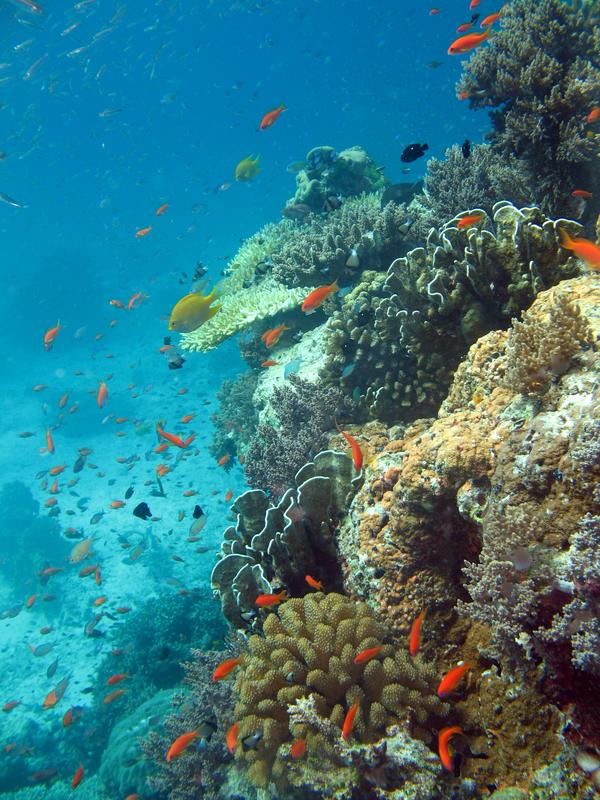What are the effects of coral reef marine protected areas?

Coral reef with plenty of fish in a National Park off Thailand. Photo: Melanie Bon, Leibniz Centre for Tropical Marine Research
With his research on coral reefs off the Indonesian island of Sulawesi, reef ecologist Dr. Sebastian Ferse from the Leibniz Centre for Tropical Marine Research (ZMT) contributed to the study. “We have been able to show that the influence of humans in the vicinity of the managed areas determines which goals of protection are achieved,” reports Ferse.
Protected areas in areas with high human impacts had only a quarter of the fish biomass compared to those in regions far from human influence. Reasons include illegal fishing and fish swimming across the boundaries of the protected zones into areas freely accessible to fishermen.
The scientists also compared protected and unprotected areas along varying degrees of human influence. “This allowed us to find out under which conditions protective measures have the greatest effect,” says Sebastian Ferse.
In regions with high human impacts, researchers found up to five times more fish biomass in protected areas than in reefs where fishing was not restricted. For most fish species, the highest effect of protection can be achieved where humans already have a fairly strong influence on the reefs. The adjacent marine areas also benefit from fish growing up in protected areas but spilling over to neighbouring reefs.
However, for the big predatory fish, such as sharks and large groupers, the results looked different. The probability of encountering these predatory fish in the protected areas at places with high human pressure was a hundred times lower than in areas far from human influence. About 200 dives were necessary to see one of the big predatory fish, but in remote places they were encountered on almost every second dive.
“This is due to the fact that large predatory fish also roam over large areas and therefore swim beyond the boundaries of the protected zone more frequently,” says Ferse. “In addition, fishing usually selectively targets the largest species, so they are also the first to be decimated”. So, according to Ferse, when it comes to protecting large predatory fish such as sharks, protection efforts are best focused on the more remote areas.
In many locations it is not realistic to enforce protected areas with a complete ban on fishing due to the local social, economic and cultural conditions. “In the study, we therefore also examined the effectiveness of fishing restrictions, which, for example, only permits selected fishing methods,” explains Sebastian Ferse.
The results were encouraging. Although the effect of partial restrictions was not as great as with complete protection, there was significantly more fish biomass in these areas than in those with no restrictions at all. “Such a concept of protection is usually easier to accept and represents a compromise,” says Ferse.
The research results point to the trade-offs between conservation objectives such as protection of large predators or maximizing fishable biomass. They thus provide environmental managers with tangible information on tailored management approaches to meet specific objectives under particular local conditions.
Publication
The study titled “The gravity of human impacts mediates coral reef conservation gains” was published online this week in the journal Proceedings of the National Academy of Sciences: www.pnas.org/cgi/doi/10.1073/pnas.1708001115
Contact
Dr. Sebastian Ferse
Leibniz Centre for Tropical Marine Research (ZMT)
Phone: 0421 / 23800-28
Email: sebastian.ferse@leibniz-zmt.de
Media Contact
All latest news from the category: Life Sciences and Chemistry
Articles and reports from the Life Sciences and chemistry area deal with applied and basic research into modern biology, chemistry and human medicine.
Valuable information can be found on a range of life sciences fields including bacteriology, biochemistry, bionics, bioinformatics, biophysics, biotechnology, genetics, geobotany, human biology, marine biology, microbiology, molecular biology, cellular biology, zoology, bioinorganic chemistry, microchemistry and environmental chemistry.
Newest articles

A ‘language’ for ML models to predict nanopore properties
A large number of 2D materials like graphene can have nanopores – small holes formed by missing atoms through which foreign substances can pass. The properties of these nanopores dictate many…

Clinically validated, wearable ultrasound patch
… for continuous blood pressure monitoring. A team of researchers at the University of California San Diego has developed a new and improved wearable ultrasound patch for continuous and noninvasive…

A new puzzle piece for string theory research
Dr. Ksenia Fedosova from the Cluster of Excellence Mathematics Münster, along with an international research team, has proven a conjecture in string theory that physicists had proposed regarding certain equations….



